Mathematical and Cognitive Development in Children: A Detailed Report
VerifiedAdded on 2020/02/24
|15
|3863
|119
Report
AI Summary
This report delves into the intricate process of mathematical and cognitive development in children, spanning from infancy to the primary school level. It begins by exploring cognitive milestones and mathematical understanding in babies (birth to two years), highlighting how they learn through observation and interaction with their environment. The report then progresses to toddlers (two to three years), discussing their increasing ability to use fingers for counting and grasp basic mathematical language. Preschoolers (three to five years) are examined, with a focus on their ability to recognize shapes and numbers, and the importance of play-based learning. The report also covers specific mathematical concepts and pedagogical approaches suitable for each age group, including practical examples of learning experiences, teaching methodologies, and assessment methods. Finally, it emphasizes the significance of providing proper guidance and support to facilitate children's cognitive growth, ensuring they are well-prepared for formal education.
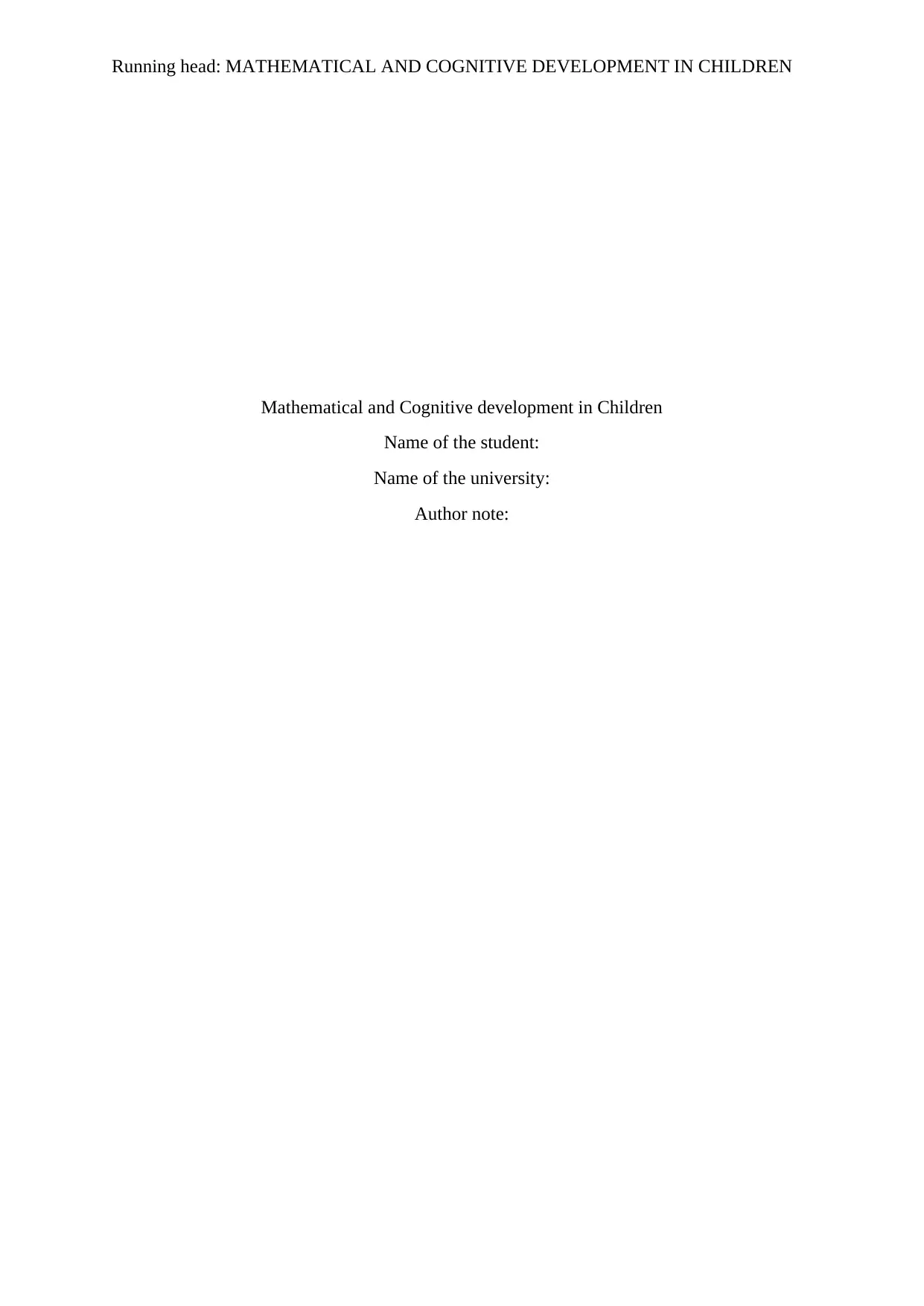
Running head: MATHEMATICAL AND COGNITIVE DEVELOPMENT IN CHILDREN
Mathematical and Cognitive development in Children
Name of the student:
Name of the university:
Author note:
Mathematical and Cognitive development in Children
Name of the student:
Name of the university:
Author note:
Paraphrase This Document
Need a fresh take? Get an instant paraphrase of this document with our AI Paraphraser
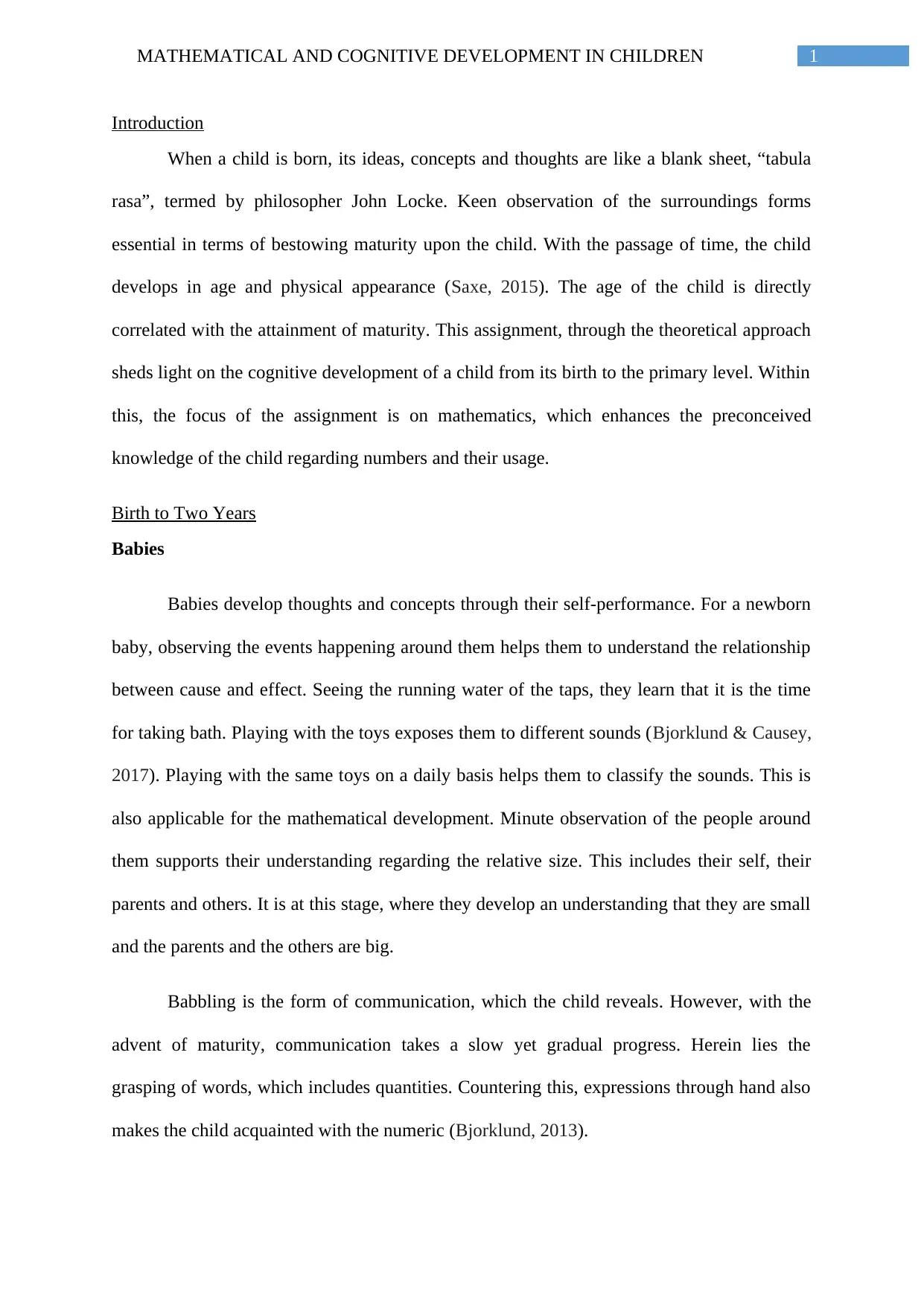
1MATHEMATICAL AND COGNITIVE DEVELOPMENT IN CHILDREN
Introduction
When a child is born, its ideas, concepts and thoughts are like a blank sheet, “tabula
rasa”, termed by philosopher John Locke. Keen observation of the surroundings forms
essential in terms of bestowing maturity upon the child. With the passage of time, the child
develops in age and physical appearance (Saxe, 2015). The age of the child is directly
correlated with the attainment of maturity. This assignment, through the theoretical approach
sheds light on the cognitive development of a child from its birth to the primary level. Within
this, the focus of the assignment is on mathematics, which enhances the preconceived
knowledge of the child regarding numbers and their usage.
Birth to Two Years
Babies
Babies develop thoughts and concepts through their self-performance. For a newborn
baby, observing the events happening around them helps them to understand the relationship
between cause and effect. Seeing the running water of the taps, they learn that it is the time
for taking bath. Playing with the toys exposes them to different sounds (Bjorklund & Causey,
2017). Playing with the same toys on a daily basis helps them to classify the sounds. This is
also applicable for the mathematical development. Minute observation of the people around
them supports their understanding regarding the relative size. This includes their self, their
parents and others. It is at this stage, where they develop an understanding that they are small
and the parents and the others are big.
Babbling is the form of communication, which the child reveals. However, with the
advent of maturity, communication takes a slow yet gradual progress. Herein lies the
grasping of words, which includes quantities. Countering this, expressions through hand also
makes the child acquainted with the numeric (Bjorklund, 2013).
Introduction
When a child is born, its ideas, concepts and thoughts are like a blank sheet, “tabula
rasa”, termed by philosopher John Locke. Keen observation of the surroundings forms
essential in terms of bestowing maturity upon the child. With the passage of time, the child
develops in age and physical appearance (Saxe, 2015). The age of the child is directly
correlated with the attainment of maturity. This assignment, through the theoretical approach
sheds light on the cognitive development of a child from its birth to the primary level. Within
this, the focus of the assignment is on mathematics, which enhances the preconceived
knowledge of the child regarding numbers and their usage.
Birth to Two Years
Babies
Babies develop thoughts and concepts through their self-performance. For a newborn
baby, observing the events happening around them helps them to understand the relationship
between cause and effect. Seeing the running water of the taps, they learn that it is the time
for taking bath. Playing with the toys exposes them to different sounds (Bjorklund & Causey,
2017). Playing with the same toys on a daily basis helps them to classify the sounds. This is
also applicable for the mathematical development. Minute observation of the people around
them supports their understanding regarding the relative size. This includes their self, their
parents and others. It is at this stage, where they develop an understanding that they are small
and the parents and the others are big.
Babbling is the form of communication, which the child reveals. However, with the
advent of maturity, communication takes a slow yet gradual progress. Herein lies the
grasping of words, which includes quantities. Countering this, expressions through hand also
makes the child acquainted with the numeric (Bjorklund, 2013).
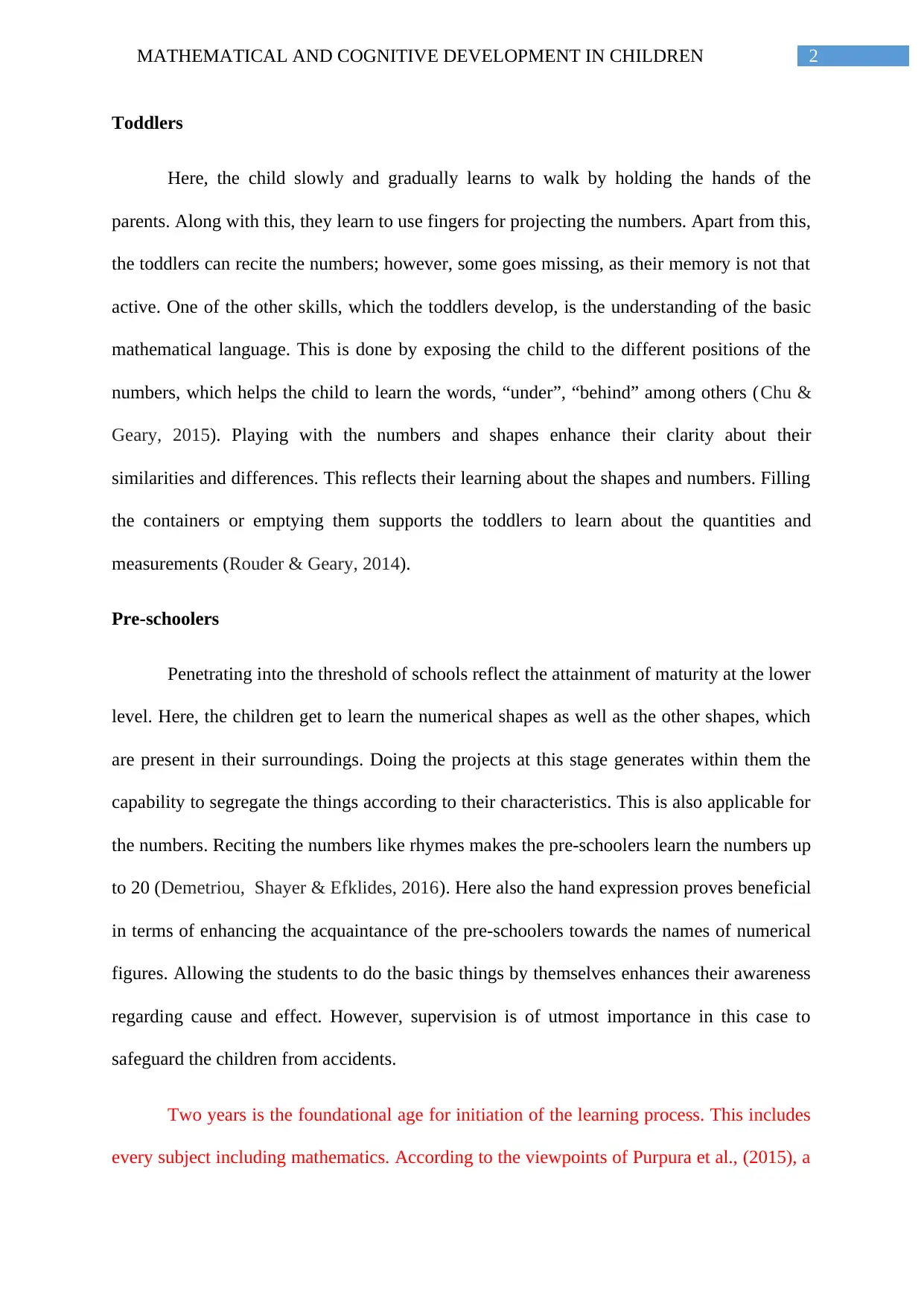
2MATHEMATICAL AND COGNITIVE DEVELOPMENT IN CHILDREN
Toddlers
Here, the child slowly and gradually learns to walk by holding the hands of the
parents. Along with this, they learn to use fingers for projecting the numbers. Apart from this,
the toddlers can recite the numbers; however, some goes missing, as their memory is not that
active. One of the other skills, which the toddlers develop, is the understanding of the basic
mathematical language. This is done by exposing the child to the different positions of the
numbers, which helps the child to learn the words, “under”, “behind” among others (Chu &
Geary, 2015). Playing with the numbers and shapes enhance their clarity about their
similarities and differences. This reflects their learning about the shapes and numbers. Filling
the containers or emptying them supports the toddlers to learn about the quantities and
measurements (Rouder & Geary, 2014).
Pre-schoolers
Penetrating into the threshold of schools reflect the attainment of maturity at the lower
level. Here, the children get to learn the numerical shapes as well as the other shapes, which
are present in their surroundings. Doing the projects at this stage generates within them the
capability to segregate the things according to their characteristics. This is also applicable for
the numbers. Reciting the numbers like rhymes makes the pre-schoolers learn the numbers up
to 20 (Demetriou, Shayer & Efklides, 2016). Here also the hand expression proves beneficial
in terms of enhancing the acquaintance of the pre-schoolers towards the names of numerical
figures. Allowing the students to do the basic things by themselves enhances their awareness
regarding cause and effect. However, supervision is of utmost importance in this case to
safeguard the children from accidents.
Two years is the foundational age for initiation of the learning process. This includes
every subject including mathematics. According to the viewpoints of Purpura et al., (2015), a
Toddlers
Here, the child slowly and gradually learns to walk by holding the hands of the
parents. Along with this, they learn to use fingers for projecting the numbers. Apart from this,
the toddlers can recite the numbers; however, some goes missing, as their memory is not that
active. One of the other skills, which the toddlers develop, is the understanding of the basic
mathematical language. This is done by exposing the child to the different positions of the
numbers, which helps the child to learn the words, “under”, “behind” among others (Chu &
Geary, 2015). Playing with the numbers and shapes enhance their clarity about their
similarities and differences. This reflects their learning about the shapes and numbers. Filling
the containers or emptying them supports the toddlers to learn about the quantities and
measurements (Rouder & Geary, 2014).
Pre-schoolers
Penetrating into the threshold of schools reflect the attainment of maturity at the lower
level. Here, the children get to learn the numerical shapes as well as the other shapes, which
are present in their surroundings. Doing the projects at this stage generates within them the
capability to segregate the things according to their characteristics. This is also applicable for
the numbers. Reciting the numbers like rhymes makes the pre-schoolers learn the numbers up
to 20 (Demetriou, Shayer & Efklides, 2016). Here also the hand expression proves beneficial
in terms of enhancing the acquaintance of the pre-schoolers towards the names of numerical
figures. Allowing the students to do the basic things by themselves enhances their awareness
regarding cause and effect. However, supervision is of utmost importance in this case to
safeguard the children from accidents.
Two years is the foundational age for initiation of the learning process. This includes
every subject including mathematics. According to the viewpoints of Purpura et al., (2015), a
⊘ This is a preview!⊘
Do you want full access?
Subscribe today to unlock all pages.

Trusted by 1+ million students worldwide
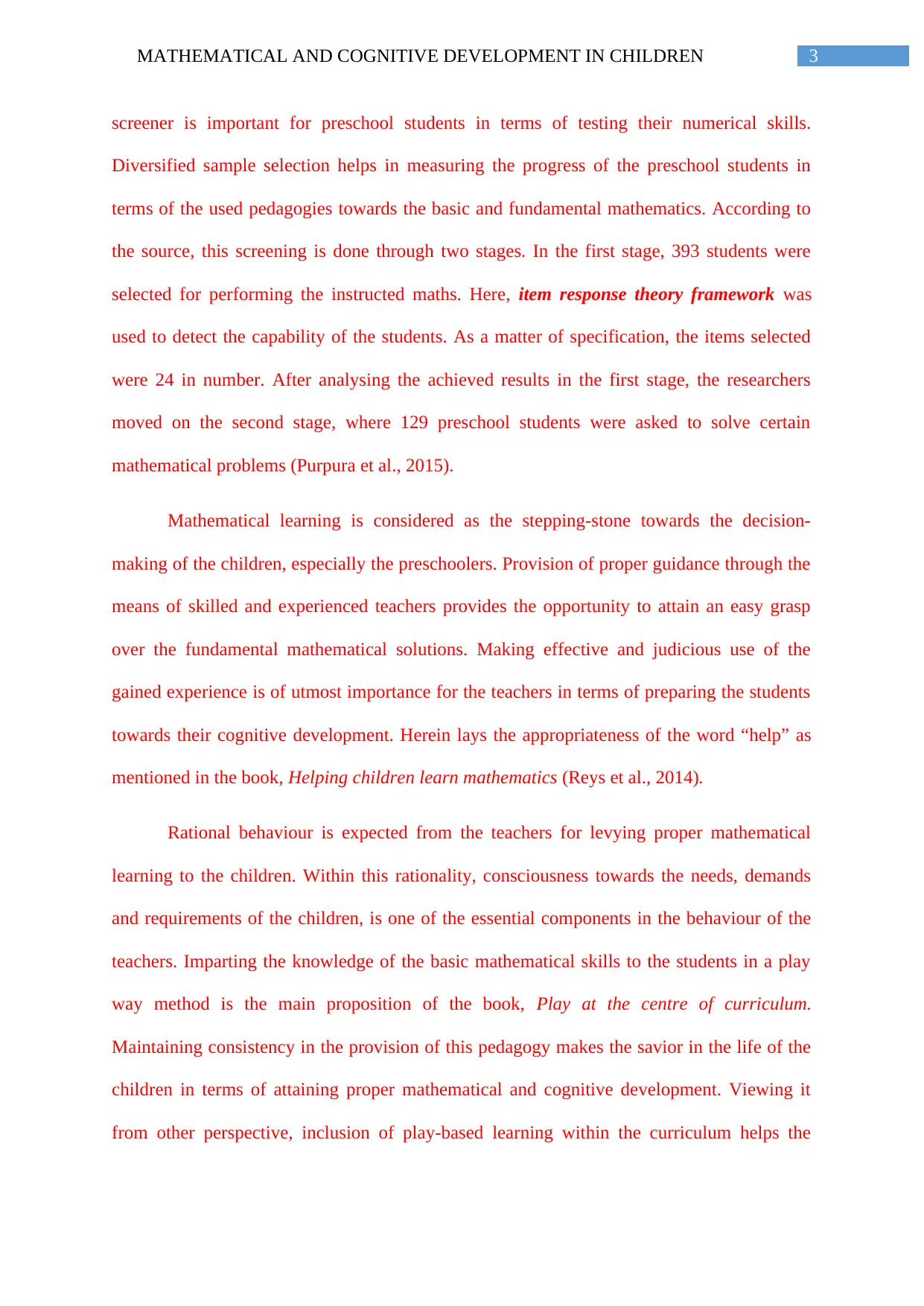
3MATHEMATICAL AND COGNITIVE DEVELOPMENT IN CHILDREN
screener is important for preschool students in terms of testing their numerical skills.
Diversified sample selection helps in measuring the progress of the preschool students in
terms of the used pedagogies towards the basic and fundamental mathematics. According to
the source, this screening is done through two stages. In the first stage, 393 students were
selected for performing the instructed maths. Here, item response theory framework was
used to detect the capability of the students. As a matter of specification, the items selected
were 24 in number. After analysing the achieved results in the first stage, the researchers
moved on the second stage, where 129 preschool students were asked to solve certain
mathematical problems (Purpura et al., 2015).
Mathematical learning is considered as the stepping-stone towards the decision-
making of the children, especially the preschoolers. Provision of proper guidance through the
means of skilled and experienced teachers provides the opportunity to attain an easy grasp
over the fundamental mathematical solutions. Making effective and judicious use of the
gained experience is of utmost importance for the teachers in terms of preparing the students
towards their cognitive development. Herein lays the appropriateness of the word “help” as
mentioned in the book, Helping children learn mathematics (Reys et al., 2014).
Rational behaviour is expected from the teachers for levying proper mathematical
learning to the children. Within this rationality, consciousness towards the needs, demands
and requirements of the children, is one of the essential components in the behaviour of the
teachers. Imparting the knowledge of the basic mathematical skills to the students in a play
way method is the main proposition of the book, Play at the centre of curriculum.
Maintaining consistency in the provision of this pedagogy makes the savior in the life of the
children in terms of attaining proper mathematical and cognitive development. Viewing it
from other perspective, inclusion of play-based learning within the curriculum helps the
screener is important for preschool students in terms of testing their numerical skills.
Diversified sample selection helps in measuring the progress of the preschool students in
terms of the used pedagogies towards the basic and fundamental mathematics. According to
the source, this screening is done through two stages. In the first stage, 393 students were
selected for performing the instructed maths. Here, item response theory framework was
used to detect the capability of the students. As a matter of specification, the items selected
were 24 in number. After analysing the achieved results in the first stage, the researchers
moved on the second stage, where 129 preschool students were asked to solve certain
mathematical problems (Purpura et al., 2015).
Mathematical learning is considered as the stepping-stone towards the decision-
making of the children, especially the preschoolers. Provision of proper guidance through the
means of skilled and experienced teachers provides the opportunity to attain an easy grasp
over the fundamental mathematical solutions. Making effective and judicious use of the
gained experience is of utmost importance for the teachers in terms of preparing the students
towards their cognitive development. Herein lays the appropriateness of the word “help” as
mentioned in the book, Helping children learn mathematics (Reys et al., 2014).
Rational behaviour is expected from the teachers for levying proper mathematical
learning to the children. Within this rationality, consciousness towards the needs, demands
and requirements of the children, is one of the essential components in the behaviour of the
teachers. Imparting the knowledge of the basic mathematical skills to the students in a play
way method is the main proposition of the book, Play at the centre of curriculum.
Maintaining consistency in the provision of this pedagogy makes the savior in the life of the
children in terms of attaining proper mathematical and cognitive development. Viewing it
from other perspective, inclusion of play-based learning within the curriculum helps the
Paraphrase This Document
Need a fresh take? Get an instant paraphrase of this document with our AI Paraphraser
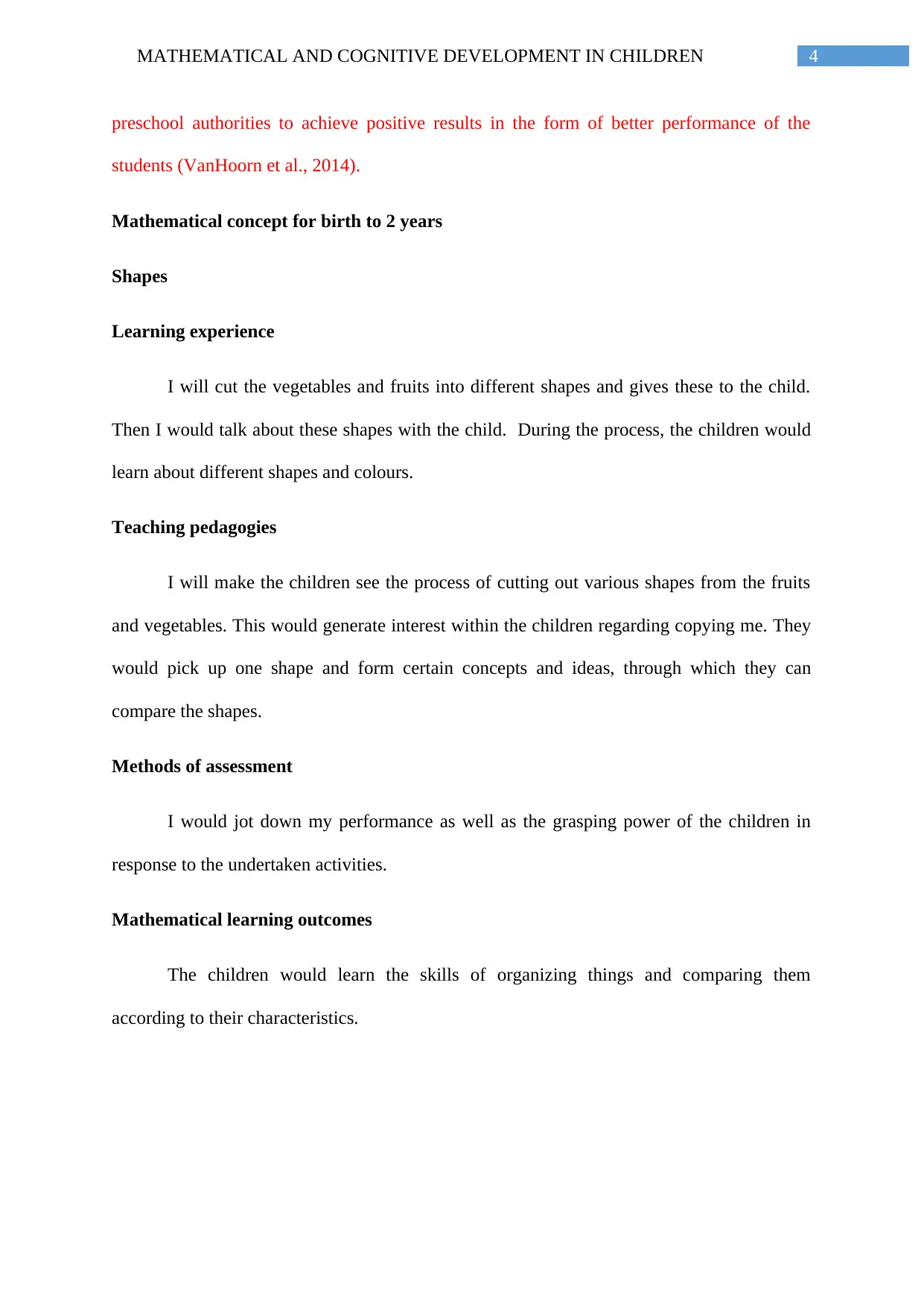
4MATHEMATICAL AND COGNITIVE DEVELOPMENT IN CHILDREN
preschool authorities to achieve positive results in the form of better performance of the
students (VanHoorn et al., 2014).
Mathematical concept for birth to 2 years
Shapes
Learning experience
I will cut the vegetables and fruits into different shapes and gives these to the child.
Then I would talk about these shapes with the child. During the process, the children would
learn about different shapes and colours.
Teaching pedagogies
I will make the children see the process of cutting out various shapes from the fruits
and vegetables. This would generate interest within the children regarding copying me. They
would pick up one shape and form certain concepts and ideas, through which they can
compare the shapes.
Methods of assessment
I would jot down my performance as well as the grasping power of the children in
response to the undertaken activities.
Mathematical learning outcomes
The children would learn the skills of organizing things and comparing them
according to their characteristics.
preschool authorities to achieve positive results in the form of better performance of the
students (VanHoorn et al., 2014).
Mathematical concept for birth to 2 years
Shapes
Learning experience
I will cut the vegetables and fruits into different shapes and gives these to the child.
Then I would talk about these shapes with the child. During the process, the children would
learn about different shapes and colours.
Teaching pedagogies
I will make the children see the process of cutting out various shapes from the fruits
and vegetables. This would generate interest within the children regarding copying me. They
would pick up one shape and form certain concepts and ideas, through which they can
compare the shapes.
Methods of assessment
I would jot down my performance as well as the grasping power of the children in
response to the undertaken activities.
Mathematical learning outcomes
The children would learn the skills of organizing things and comparing them
according to their characteristics.
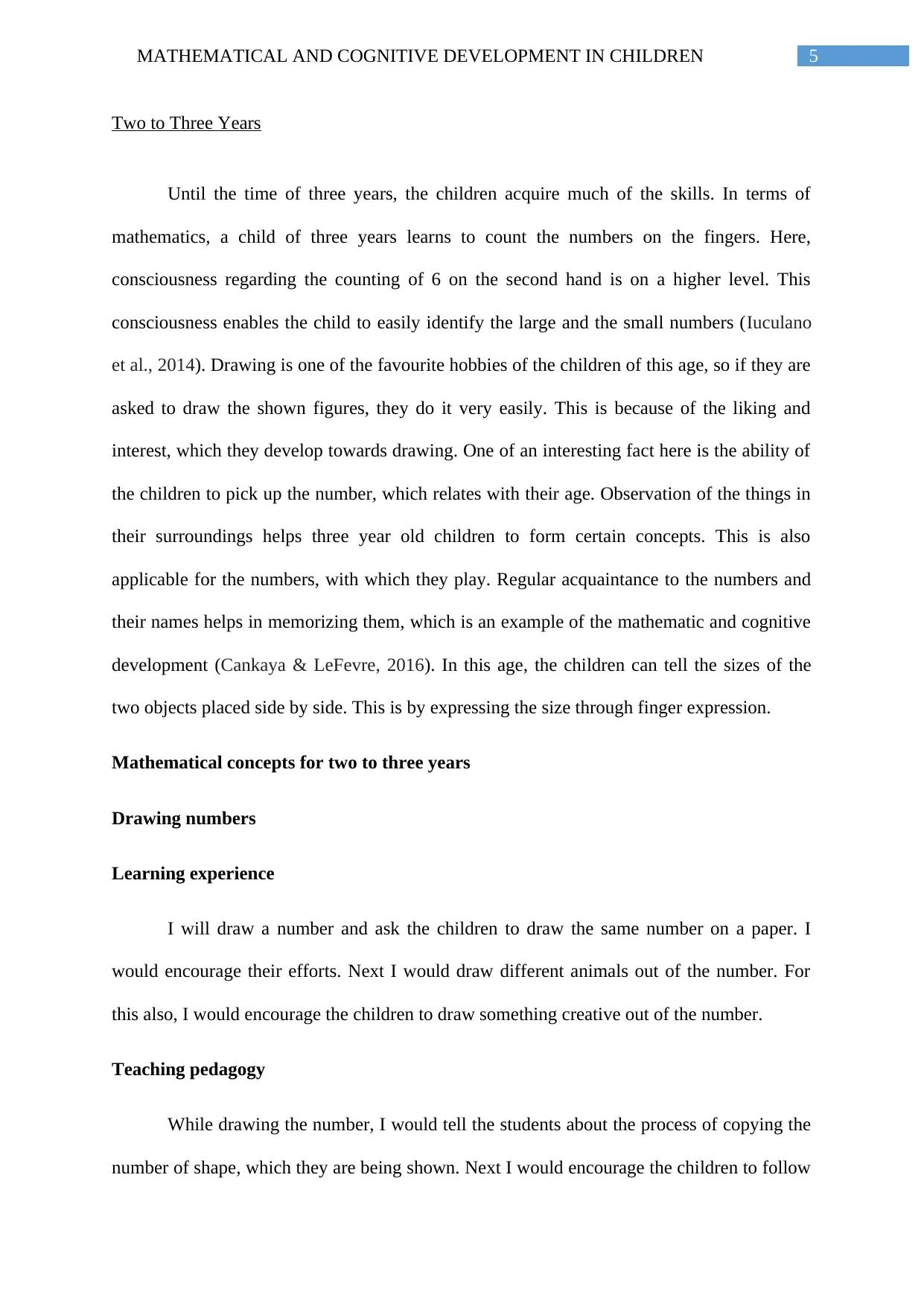
5MATHEMATICAL AND COGNITIVE DEVELOPMENT IN CHILDREN
Two to Three Years
Until the time of three years, the children acquire much of the skills. In terms of
mathematics, a child of three years learns to count the numbers on the fingers. Here,
consciousness regarding the counting of 6 on the second hand is on a higher level. This
consciousness enables the child to easily identify the large and the small numbers (Iuculano
et al., 2014). Drawing is one of the favourite hobbies of the children of this age, so if they are
asked to draw the shown figures, they do it very easily. This is because of the liking and
interest, which they develop towards drawing. One of an interesting fact here is the ability of
the children to pick up the number, which relates with their age. Observation of the things in
their surroundings helps three year old children to form certain concepts. This is also
applicable for the numbers, with which they play. Regular acquaintance to the numbers and
their names helps in memorizing them, which is an example of the mathematic and cognitive
development (Cankaya & LeFevre, 2016). In this age, the children can tell the sizes of the
two objects placed side by side. This is by expressing the size through finger expression.
Mathematical concepts for two to three years
Drawing numbers
Learning experience
I will draw a number and ask the children to draw the same number on a paper. I
would encourage their efforts. Next I would draw different animals out of the number. For
this also, I would encourage the children to draw something creative out of the number.
Teaching pedagogy
While drawing the number, I would tell the students about the process of copying the
number of shape, which they are being shown. Next I would encourage the children to follow
Two to Three Years
Until the time of three years, the children acquire much of the skills. In terms of
mathematics, a child of three years learns to count the numbers on the fingers. Here,
consciousness regarding the counting of 6 on the second hand is on a higher level. This
consciousness enables the child to easily identify the large and the small numbers (Iuculano
et al., 2014). Drawing is one of the favourite hobbies of the children of this age, so if they are
asked to draw the shown figures, they do it very easily. This is because of the liking and
interest, which they develop towards drawing. One of an interesting fact here is the ability of
the children to pick up the number, which relates with their age. Observation of the things in
their surroundings helps three year old children to form certain concepts. This is also
applicable for the numbers, with which they play. Regular acquaintance to the numbers and
their names helps in memorizing them, which is an example of the mathematic and cognitive
development (Cankaya & LeFevre, 2016). In this age, the children can tell the sizes of the
two objects placed side by side. This is by expressing the size through finger expression.
Mathematical concepts for two to three years
Drawing numbers
Learning experience
I will draw a number and ask the children to draw the same number on a paper. I
would encourage their efforts. Next I would draw different animals out of the number. For
this also, I would encourage the children to draw something creative out of the number.
Teaching pedagogy
While drawing the number, I would tell the students about the process of copying the
number of shape, which they are being shown. Next I would encourage the children to follow
⊘ This is a preview!⊘
Do you want full access?
Subscribe today to unlock all pages.

Trusted by 1+ million students worldwide
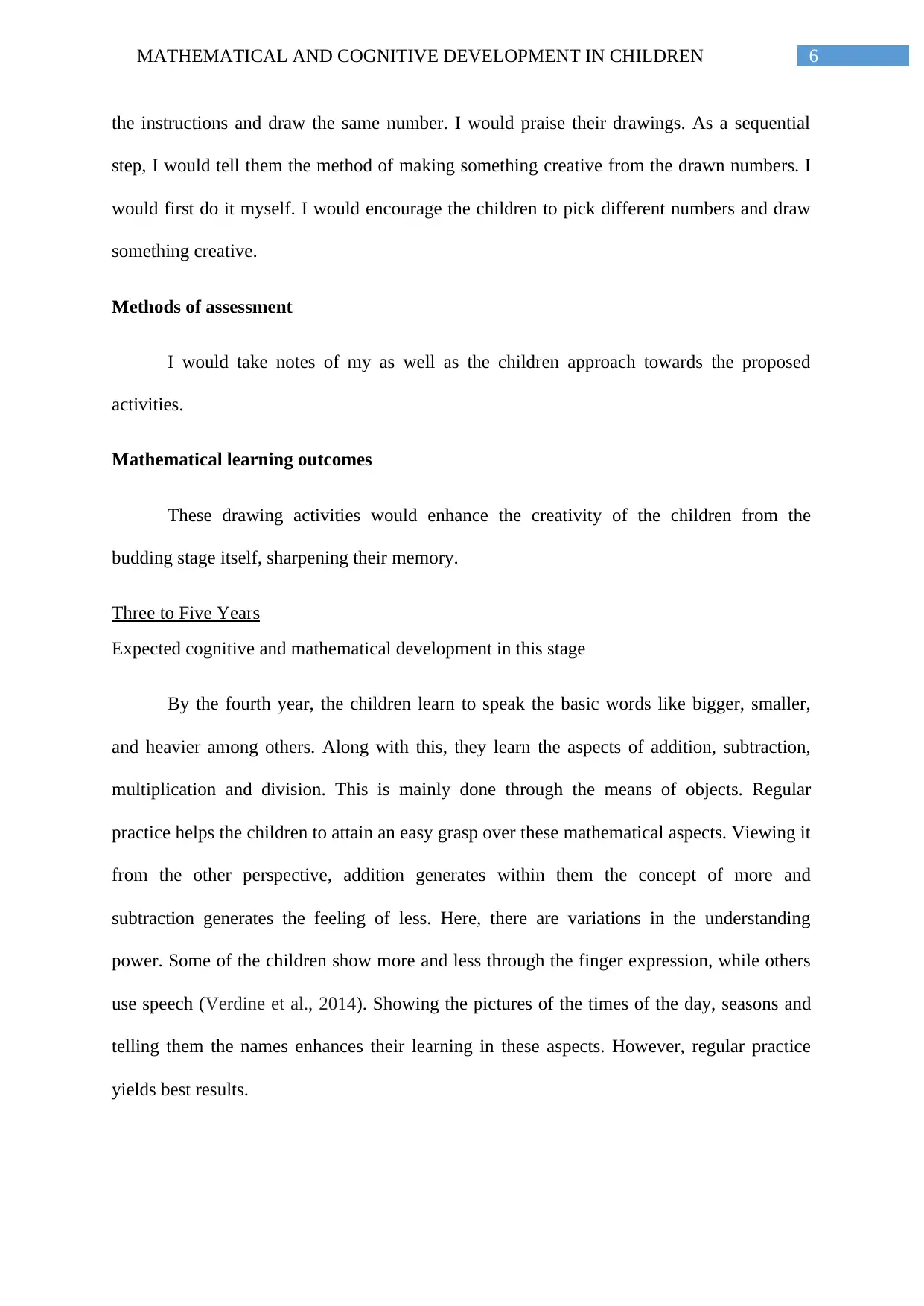
6MATHEMATICAL AND COGNITIVE DEVELOPMENT IN CHILDREN
the instructions and draw the same number. I would praise their drawings. As a sequential
step, I would tell them the method of making something creative from the drawn numbers. I
would first do it myself. I would encourage the children to pick different numbers and draw
something creative.
Methods of assessment
I would take notes of my as well as the children approach towards the proposed
activities.
Mathematical learning outcomes
These drawing activities would enhance the creativity of the children from the
budding stage itself, sharpening their memory.
Three to Five Years
Expected cognitive and mathematical development in this stage
By the fourth year, the children learn to speak the basic words like bigger, smaller,
and heavier among others. Along with this, they learn the aspects of addition, subtraction,
multiplication and division. This is mainly done through the means of objects. Regular
practice helps the children to attain an easy grasp over these mathematical aspects. Viewing it
from the other perspective, addition generates within them the concept of more and
subtraction generates the feeling of less. Here, there are variations in the understanding
power. Some of the children show more and less through the finger expression, while others
use speech (Verdine et al., 2014). Showing the pictures of the times of the day, seasons and
telling them the names enhances their learning in these aspects. However, regular practice
yields best results.
the instructions and draw the same number. I would praise their drawings. As a sequential
step, I would tell them the method of making something creative from the drawn numbers. I
would first do it myself. I would encourage the children to pick different numbers and draw
something creative.
Methods of assessment
I would take notes of my as well as the children approach towards the proposed
activities.
Mathematical learning outcomes
These drawing activities would enhance the creativity of the children from the
budding stage itself, sharpening their memory.
Three to Five Years
Expected cognitive and mathematical development in this stage
By the fourth year, the children learn to speak the basic words like bigger, smaller,
and heavier among others. Along with this, they learn the aspects of addition, subtraction,
multiplication and division. This is mainly done through the means of objects. Regular
practice helps the children to attain an easy grasp over these mathematical aspects. Viewing it
from the other perspective, addition generates within them the concept of more and
subtraction generates the feeling of less. Here, there are variations in the understanding
power. Some of the children show more and less through the finger expression, while others
use speech (Verdine et al., 2014). Showing the pictures of the times of the day, seasons and
telling them the names enhances their learning in these aspects. However, regular practice
yields best results.
Paraphrase This Document
Need a fresh take? Get an instant paraphrase of this document with our AI Paraphraser
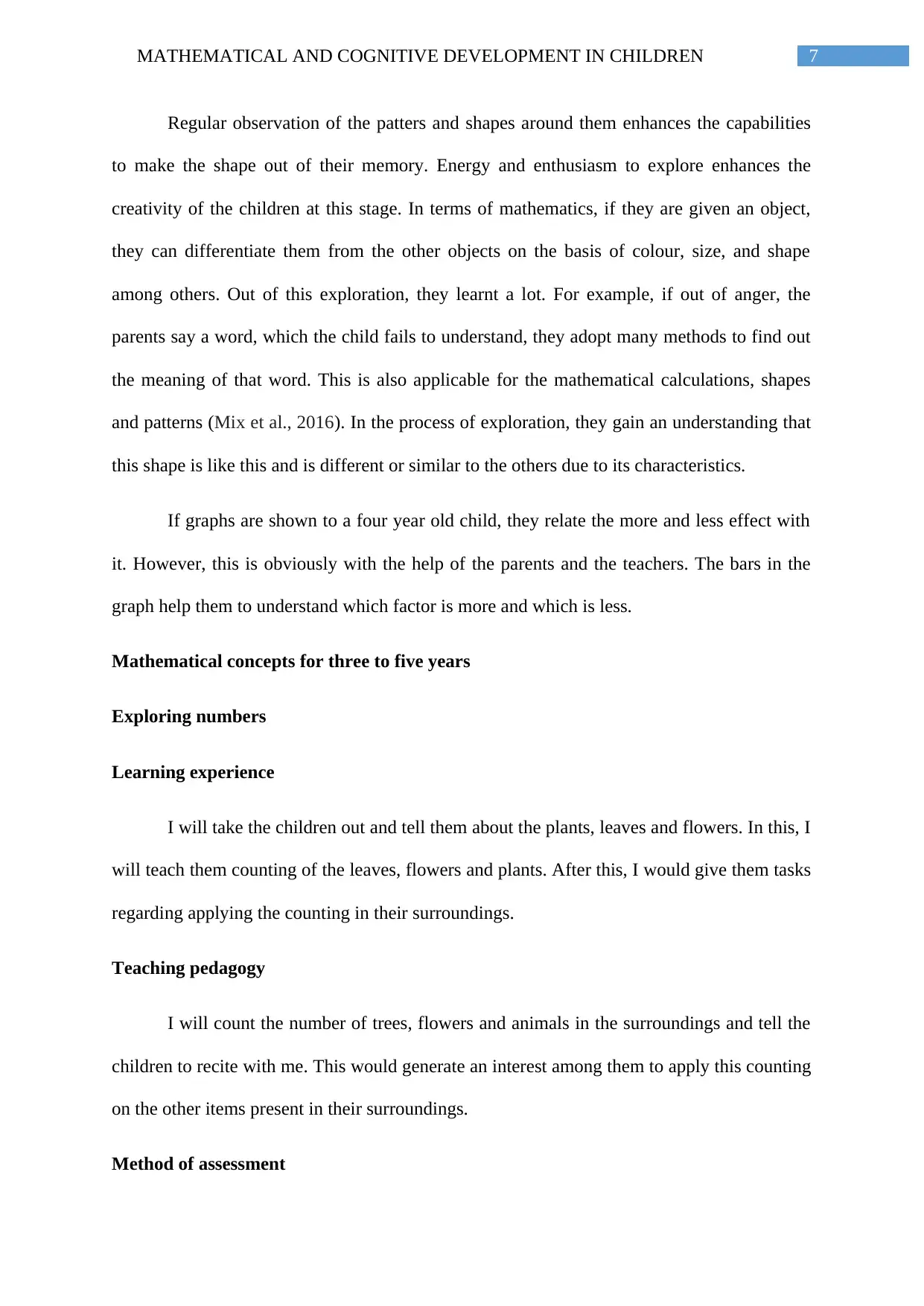
7MATHEMATICAL AND COGNITIVE DEVELOPMENT IN CHILDREN
Regular observation of the patters and shapes around them enhances the capabilities
to make the shape out of their memory. Energy and enthusiasm to explore enhances the
creativity of the children at this stage. In terms of mathematics, if they are given an object,
they can differentiate them from the other objects on the basis of colour, size, and shape
among others. Out of this exploration, they learnt a lot. For example, if out of anger, the
parents say a word, which the child fails to understand, they adopt many methods to find out
the meaning of that word. This is also applicable for the mathematical calculations, shapes
and patterns (Mix et al., 2016). In the process of exploration, they gain an understanding that
this shape is like this and is different or similar to the others due to its characteristics.
If graphs are shown to a four year old child, they relate the more and less effect with
it. However, this is obviously with the help of the parents and the teachers. The bars in the
graph help them to understand which factor is more and which is less.
Mathematical concepts for three to five years
Exploring numbers
Learning experience
I will take the children out and tell them about the plants, leaves and flowers. In this, I
will teach them counting of the leaves, flowers and plants. After this, I would give them tasks
regarding applying the counting in their surroundings.
Teaching pedagogy
I will count the number of trees, flowers and animals in the surroundings and tell the
children to recite with me. This would generate an interest among them to apply this counting
on the other items present in their surroundings.
Method of assessment
Regular observation of the patters and shapes around them enhances the capabilities
to make the shape out of their memory. Energy and enthusiasm to explore enhances the
creativity of the children at this stage. In terms of mathematics, if they are given an object,
they can differentiate them from the other objects on the basis of colour, size, and shape
among others. Out of this exploration, they learnt a lot. For example, if out of anger, the
parents say a word, which the child fails to understand, they adopt many methods to find out
the meaning of that word. This is also applicable for the mathematical calculations, shapes
and patterns (Mix et al., 2016). In the process of exploration, they gain an understanding that
this shape is like this and is different or similar to the others due to its characteristics.
If graphs are shown to a four year old child, they relate the more and less effect with
it. However, this is obviously with the help of the parents and the teachers. The bars in the
graph help them to understand which factor is more and which is less.
Mathematical concepts for three to five years
Exploring numbers
Learning experience
I will take the children out and tell them about the plants, leaves and flowers. In this, I
will teach them counting of the leaves, flowers and plants. After this, I would give them tasks
regarding applying the counting in their surroundings.
Teaching pedagogy
I will count the number of trees, flowers and animals in the surroundings and tell the
children to recite with me. This would generate an interest among them to apply this counting
on the other items present in their surroundings.
Method of assessment
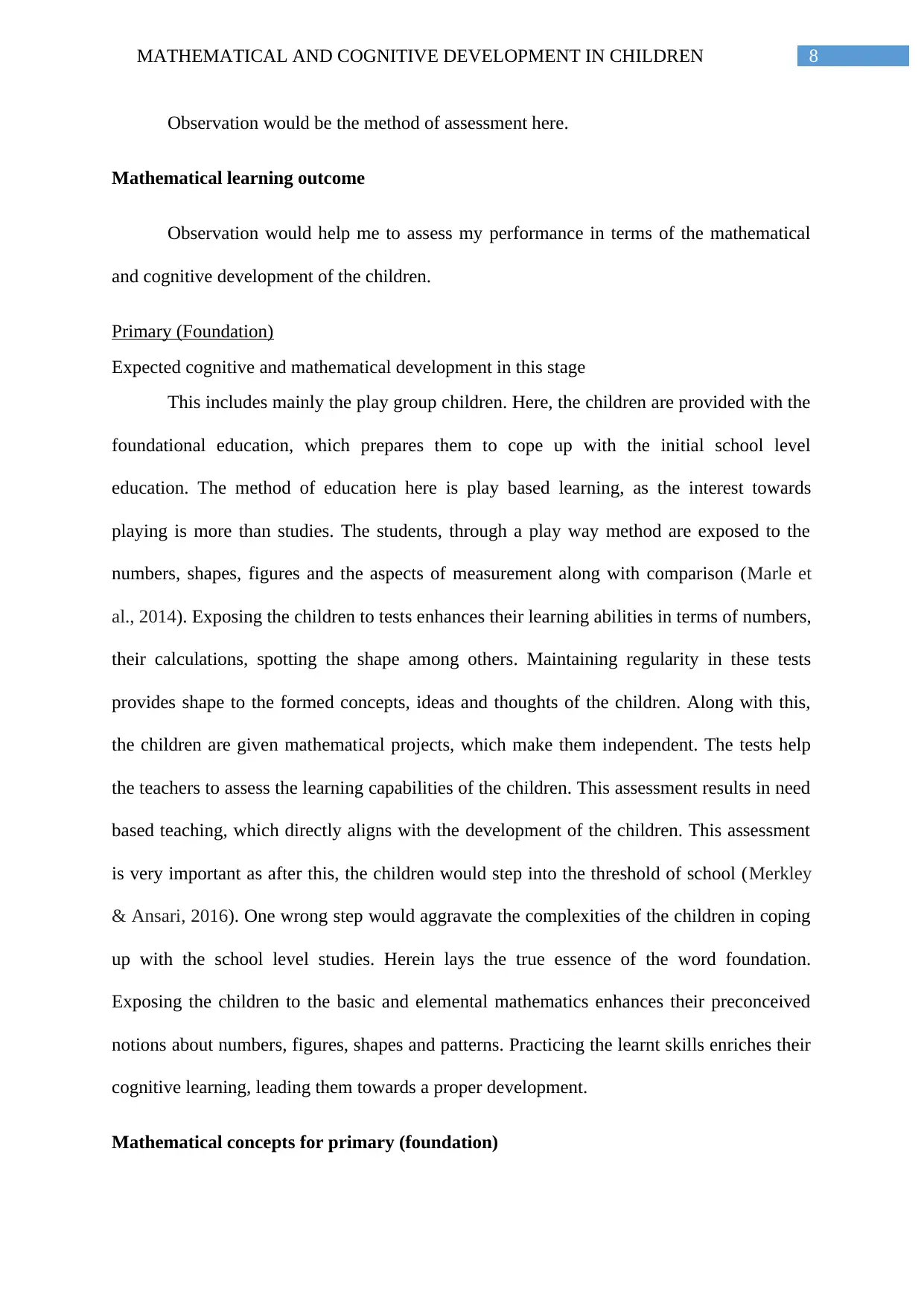
8MATHEMATICAL AND COGNITIVE DEVELOPMENT IN CHILDREN
Observation would be the method of assessment here.
Mathematical learning outcome
Observation would help me to assess my performance in terms of the mathematical
and cognitive development of the children.
Primary (Foundation)
Expected cognitive and mathematical development in this stage
This includes mainly the play group children. Here, the children are provided with the
foundational education, which prepares them to cope up with the initial school level
education. The method of education here is play based learning, as the interest towards
playing is more than studies. The students, through a play way method are exposed to the
numbers, shapes, figures and the aspects of measurement along with comparison (Marle et
al., 2014). Exposing the children to tests enhances their learning abilities in terms of numbers,
their calculations, spotting the shape among others. Maintaining regularity in these tests
provides shape to the formed concepts, ideas and thoughts of the children. Along with this,
the children are given mathematical projects, which make them independent. The tests help
the teachers to assess the learning capabilities of the children. This assessment results in need
based teaching, which directly aligns with the development of the children. This assessment
is very important as after this, the children would step into the threshold of school (Merkley
& Ansari, 2016). One wrong step would aggravate the complexities of the children in coping
up with the school level studies. Herein lays the true essence of the word foundation.
Exposing the children to the basic and elemental mathematics enhances their preconceived
notions about numbers, figures, shapes and patterns. Practicing the learnt skills enriches their
cognitive learning, leading them towards a proper development.
Mathematical concepts for primary (foundation)
Observation would be the method of assessment here.
Mathematical learning outcome
Observation would help me to assess my performance in terms of the mathematical
and cognitive development of the children.
Primary (Foundation)
Expected cognitive and mathematical development in this stage
This includes mainly the play group children. Here, the children are provided with the
foundational education, which prepares them to cope up with the initial school level
education. The method of education here is play based learning, as the interest towards
playing is more than studies. The students, through a play way method are exposed to the
numbers, shapes, figures and the aspects of measurement along with comparison (Marle et
al., 2014). Exposing the children to tests enhances their learning abilities in terms of numbers,
their calculations, spotting the shape among others. Maintaining regularity in these tests
provides shape to the formed concepts, ideas and thoughts of the children. Along with this,
the children are given mathematical projects, which make them independent. The tests help
the teachers to assess the learning capabilities of the children. This assessment results in need
based teaching, which directly aligns with the development of the children. This assessment
is very important as after this, the children would step into the threshold of school (Merkley
& Ansari, 2016). One wrong step would aggravate the complexities of the children in coping
up with the school level studies. Herein lays the true essence of the word foundation.
Exposing the children to the basic and elemental mathematics enhances their preconceived
notions about numbers, figures, shapes and patterns. Practicing the learnt skills enriches their
cognitive learning, leading them towards a proper development.
Mathematical concepts for primary (foundation)
⊘ This is a preview!⊘
Do you want full access?
Subscribe today to unlock all pages.

Trusted by 1+ million students worldwide
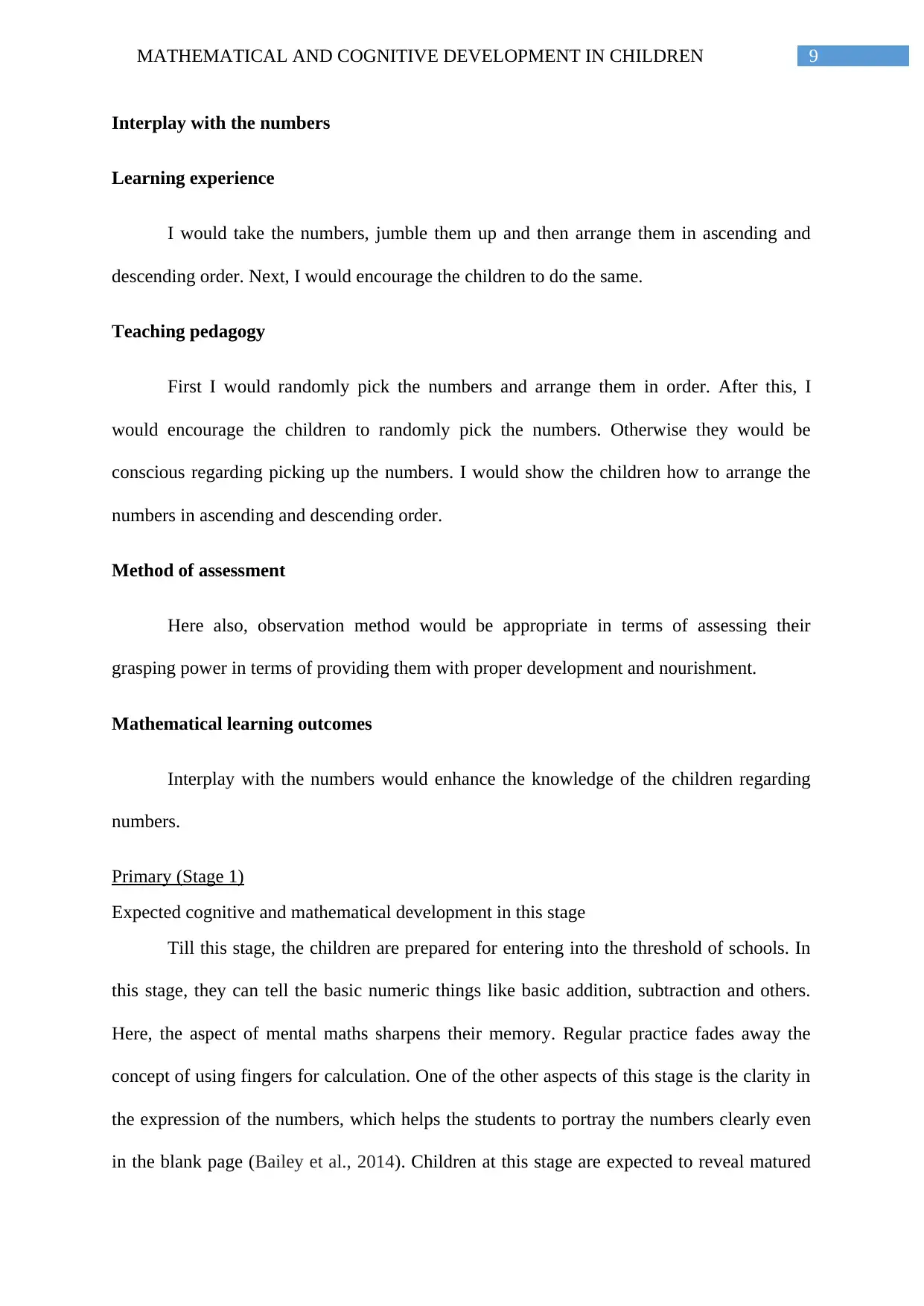
9MATHEMATICAL AND COGNITIVE DEVELOPMENT IN CHILDREN
Interplay with the numbers
Learning experience
I would take the numbers, jumble them up and then arrange them in ascending and
descending order. Next, I would encourage the children to do the same.
Teaching pedagogy
First I would randomly pick the numbers and arrange them in order. After this, I
would encourage the children to randomly pick the numbers. Otherwise they would be
conscious regarding picking up the numbers. I would show the children how to arrange the
numbers in ascending and descending order.
Method of assessment
Here also, observation method would be appropriate in terms of assessing their
grasping power in terms of providing them with proper development and nourishment.
Mathematical learning outcomes
Interplay with the numbers would enhance the knowledge of the children regarding
numbers.
Primary (Stage 1)
Expected cognitive and mathematical development in this stage
Till this stage, the children are prepared for entering into the threshold of schools. In
this stage, they can tell the basic numeric things like basic addition, subtraction and others.
Here, the aspect of mental maths sharpens their memory. Regular practice fades away the
concept of using fingers for calculation. One of the other aspects of this stage is the clarity in
the expression of the numbers, which helps the students to portray the numbers clearly even
in the blank page (Bailey et al., 2014). Children at this stage are expected to reveal matured
Interplay with the numbers
Learning experience
I would take the numbers, jumble them up and then arrange them in ascending and
descending order. Next, I would encourage the children to do the same.
Teaching pedagogy
First I would randomly pick the numbers and arrange them in order. After this, I
would encourage the children to randomly pick the numbers. Otherwise they would be
conscious regarding picking up the numbers. I would show the children how to arrange the
numbers in ascending and descending order.
Method of assessment
Here also, observation method would be appropriate in terms of assessing their
grasping power in terms of providing them with proper development and nourishment.
Mathematical learning outcomes
Interplay with the numbers would enhance the knowledge of the children regarding
numbers.
Primary (Stage 1)
Expected cognitive and mathematical development in this stage
Till this stage, the children are prepared for entering into the threshold of schools. In
this stage, they can tell the basic numeric things like basic addition, subtraction and others.
Here, the aspect of mental maths sharpens their memory. Regular practice fades away the
concept of using fingers for calculation. One of the other aspects of this stage is the clarity in
the expression of the numbers, which helps the students to portray the numbers clearly even
in the blank page (Bailey et al., 2014). Children at this stage are expected to reveal matured
Paraphrase This Document
Need a fresh take? Get an instant paraphrase of this document with our AI Paraphraser
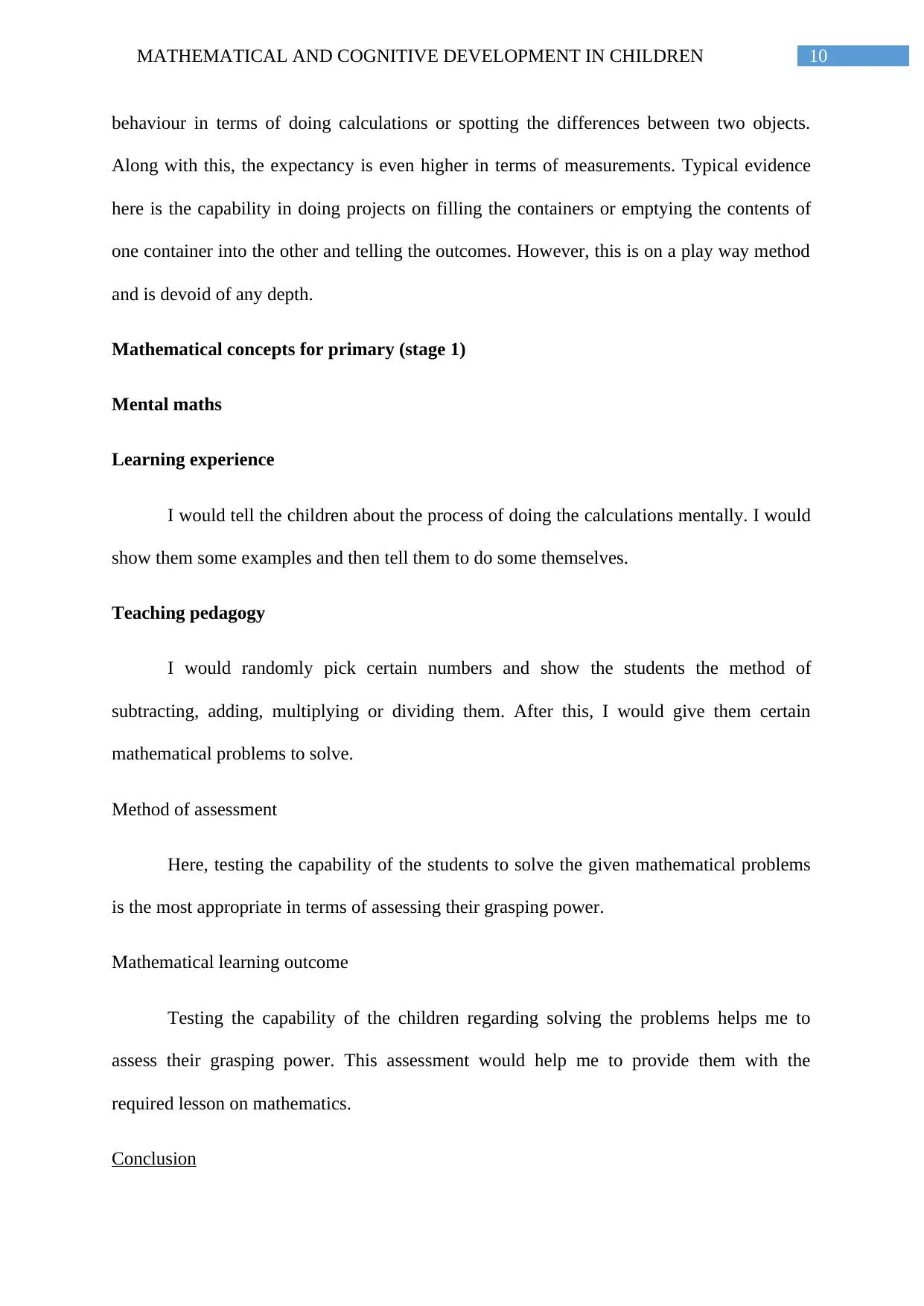
10MATHEMATICAL AND COGNITIVE DEVELOPMENT IN CHILDREN
behaviour in terms of doing calculations or spotting the differences between two objects.
Along with this, the expectancy is even higher in terms of measurements. Typical evidence
here is the capability in doing projects on filling the containers or emptying the contents of
one container into the other and telling the outcomes. However, this is on a play way method
and is devoid of any depth.
Mathematical concepts for primary (stage 1)
Mental maths
Learning experience
I would tell the children about the process of doing the calculations mentally. I would
show them some examples and then tell them to do some themselves.
Teaching pedagogy
I would randomly pick certain numbers and show the students the method of
subtracting, adding, multiplying or dividing them. After this, I would give them certain
mathematical problems to solve.
Method of assessment
Here, testing the capability of the students to solve the given mathematical problems
is the most appropriate in terms of assessing their grasping power.
Mathematical learning outcome
Testing the capability of the children regarding solving the problems helps me to
assess their grasping power. This assessment would help me to provide them with the
required lesson on mathematics.
Conclusion
behaviour in terms of doing calculations or spotting the differences between two objects.
Along with this, the expectancy is even higher in terms of measurements. Typical evidence
here is the capability in doing projects on filling the containers or emptying the contents of
one container into the other and telling the outcomes. However, this is on a play way method
and is devoid of any depth.
Mathematical concepts for primary (stage 1)
Mental maths
Learning experience
I would tell the children about the process of doing the calculations mentally. I would
show them some examples and then tell them to do some themselves.
Teaching pedagogy
I would randomly pick certain numbers and show the students the method of
subtracting, adding, multiplying or dividing them. After this, I would give them certain
mathematical problems to solve.
Method of assessment
Here, testing the capability of the students to solve the given mathematical problems
is the most appropriate in terms of assessing their grasping power.
Mathematical learning outcome
Testing the capability of the children regarding solving the problems helps me to
assess their grasping power. This assessment would help me to provide them with the
required lesson on mathematics.
Conclusion
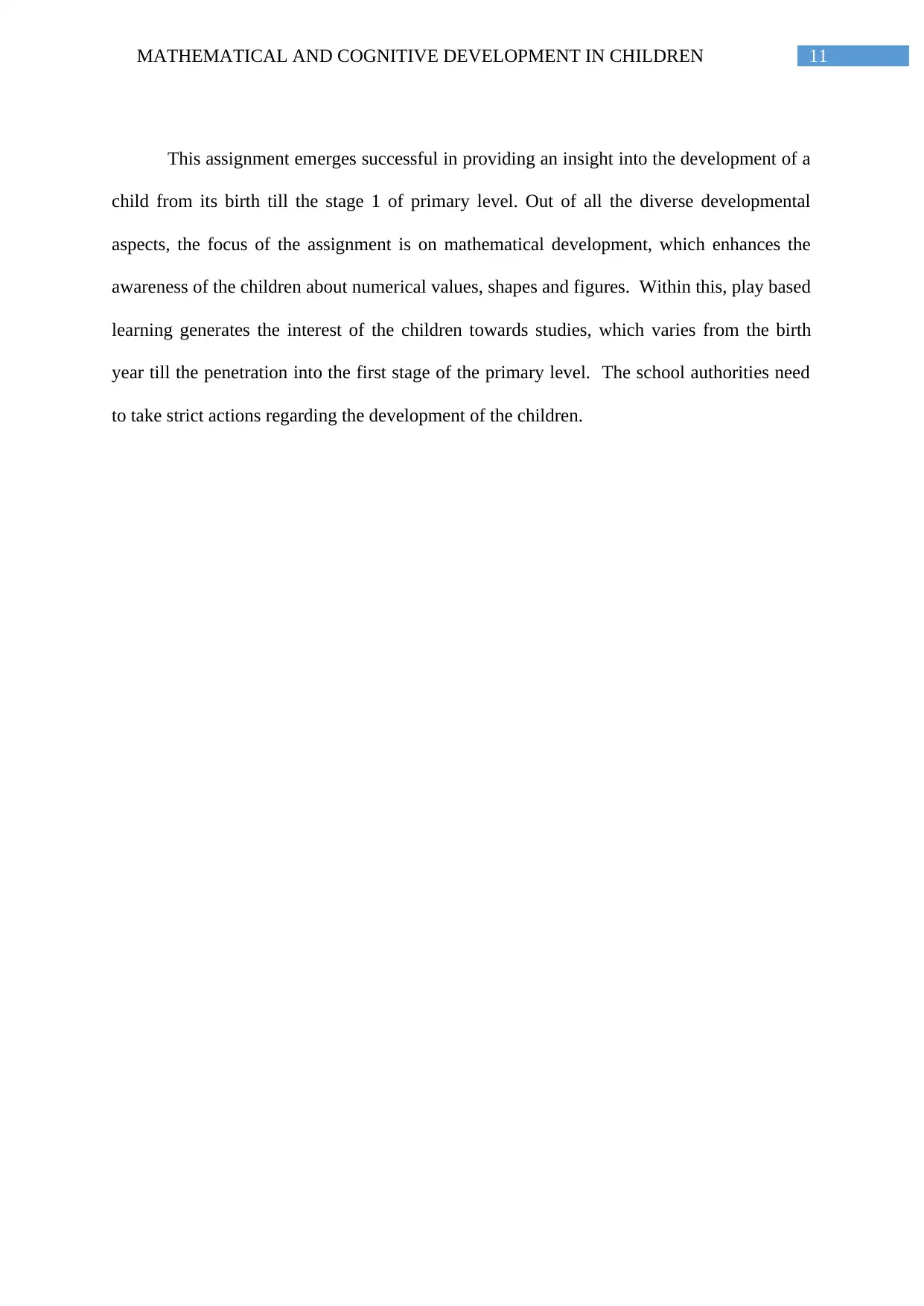
11MATHEMATICAL AND COGNITIVE DEVELOPMENT IN CHILDREN
This assignment emerges successful in providing an insight into the development of a
child from its birth till the stage 1 of primary level. Out of all the diverse developmental
aspects, the focus of the assignment is on mathematical development, which enhances the
awareness of the children about numerical values, shapes and figures. Within this, play based
learning generates the interest of the children towards studies, which varies from the birth
year till the penetration into the first stage of the primary level. The school authorities need
to take strict actions regarding the development of the children.
This assignment emerges successful in providing an insight into the development of a
child from its birth till the stage 1 of primary level. Out of all the diverse developmental
aspects, the focus of the assignment is on mathematical development, which enhances the
awareness of the children about numerical values, shapes and figures. Within this, play based
learning generates the interest of the children towards studies, which varies from the birth
year till the penetration into the first stage of the primary level. The school authorities need
to take strict actions regarding the development of the children.
⊘ This is a preview!⊘
Do you want full access?
Subscribe today to unlock all pages.

Trusted by 1+ million students worldwide
1 out of 15
Related Documents
Your All-in-One AI-Powered Toolkit for Academic Success.
+13062052269
info@desklib.com
Available 24*7 on WhatsApp / Email
![[object Object]](/_next/static/media/star-bottom.7253800d.svg)
Unlock your academic potential
Copyright © 2020–2025 A2Z Services. All Rights Reserved. Developed and managed by ZUCOL.





